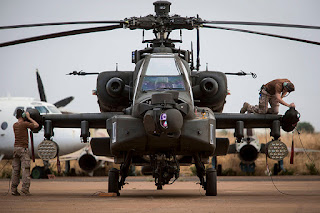An attack helicopter is an armed helicopter with the primary role of an attack aircraft, with the offensive capability of engaging ground targets such as enemy infantry, military vehicles and fortifications. Due to their heavy armament they are sometimes called helicopter gunships.
 Attack helicopters can use weapons including autocannons, machine guns, rockets and guided anti-tank missiles such as the AGM-114 Hellfire. Some attack helicopters are also capable of carrying air-to-air missiles, though mostly for purposes of self-defense against other helicopters and low-flying light combat aircraft.
Attack helicopters can use weapons including autocannons, machine guns, rockets and guided anti-tank missiles such as the AGM-114 Hellfire. Some attack helicopters are also capable of carrying air-to-air missiles, though mostly for purposes of self-defense against other helicopters and low-flying light combat aircraft.A modern attack helicopter has two main roles: first, to provide direct and accurate close air support for ground troops; and second, the anti-tank role to destroy grouped enemy armor. Attack helicopters are also used as protective escort for transport helicopters, or to supplement lighter helicopters in the armed reconnaissance roles. In combat, an attack helicopter is projected to destroy targets worthing around 17 times its own production cost before being destroyed.
Low-speed, fixed wing Allied aircraft like the Soviet Polikarpov Po-2 training and utility biplane had been used as early as 1942 to provide night harassment attack capability against the Wehrmacht Heer on the Eastern Front, most effectively in the Battle of the Caucasus as exemplified by the Night Witches all-female Soviet air unit. Following Operation Overlord in 1944, the military version of the similarly slow-flying Piper J-3 Cub high-wing civilian monoplane, the L-4 Grasshopper, begun to be used in a light anti-armor role by a few U.S. Army artillery spotter units over France; these aircraft were field-outfitted with either two or four bazooka rocket launchers attached to the lift struts, against German armored fighting vehicles.
During the summer of 1944, U.S. Army Major Charles Carpenter managed to successfully take on an anti-armor role with his rocket-armed Piper L-4. His L-4, bearing US Army serial number 43-30426 and named Rosie the Rocketer, armed with six bazookas, had a notable anti-armor success during an engagement during the Battle of Arracourt on September 20, 1944, employing top attack tactics in knocking out at least four German armored vehicles, as a pioneering example of taking on heavy enemy armor from a slow-flying aircraft. More details